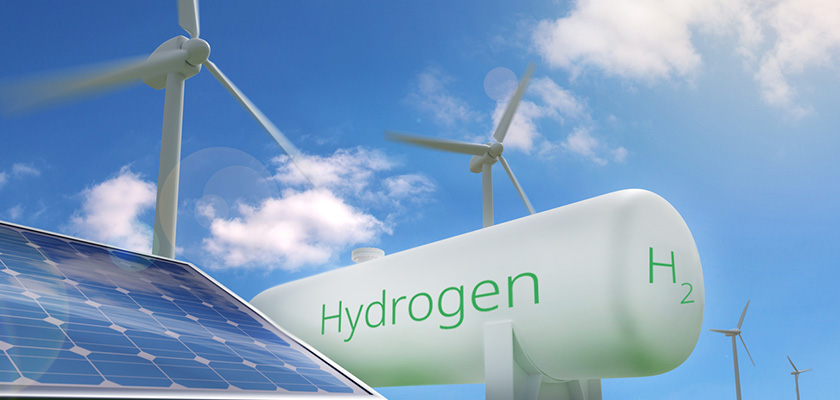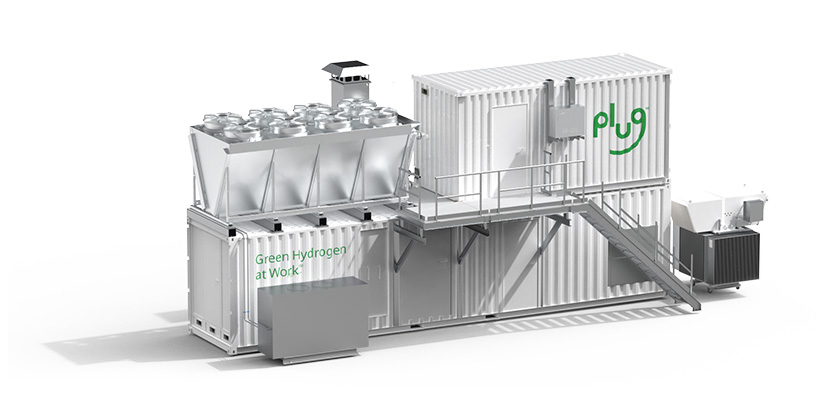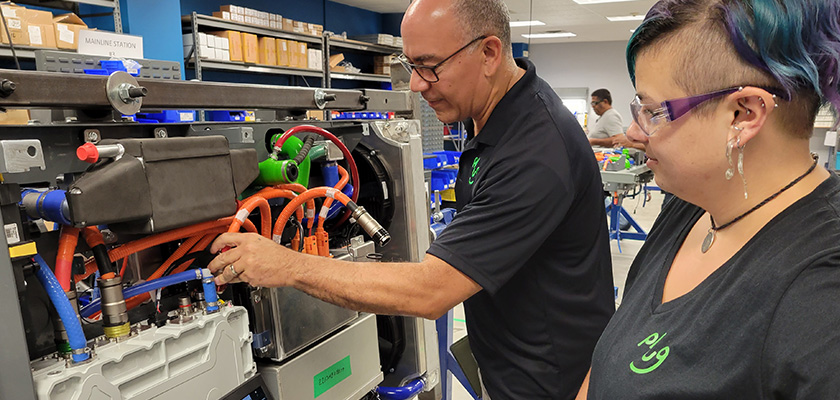Green Hydrogen 101: Unlocking the Potential of This Renewable Energy Source


Green hydrogen has become increasingly vital in plans to cut greenhouse gas emissions and improve air quality, which is why global leaders have turned to Plug for green hydrogen solutions. Here’s everything you need to know about the clean energy source.
A: Introduction to Green Hydrogen and its Potential as a Renewable Energy Source
You can’t talk about the A to Z of green hydrogen without answering the question: What is green hydrogen?
Green hydrogen is produced from electrolyzers using renewable energy sources to provide the required power. It differs from other hydrogen colors — such as blue, pink, and gray — because it is the only one that doesn’t use either fossil fuels or nuclear power.

Taking a step back to the basics of hydrogen, the chemical compound is one of 118 known elements and sits as among “the most abundant element in the universe,” according to the U.S. Energy Information Administration, at roughly 75% of the universe makeup.
While green hydrogen and hydrogen at-large today consists of a microscopic fraction of the global energy mix, Goldman Sachs predicts that by 2050, that number will jump to 25% and have a market segment worth $10 trillion.
B: Benefits of Green Hydrogen and its Ability to Reduce Greenhouse Gas Emissions
Compared to its other-colored counterparts, green hydrogen provides a major greenhouse gas reduction benefit because its energy input is not an emitter and its output is benign: water.

Dr. Emanuele Taibi, Head of the Power Sector Transformation Strategies, International Renewable Energy Agency (IRENA), told the World Economic Forum that green hydrogen will be crucial “to reach net zero emissions, in particular for industry, shipping and aviation.”
In addition, Plug CEO Andy Marsh told Congress in July 2022 that hydrogen may be the only viable pathway to reduce emissions for difficult-to-decarbonize sectors, such as rail and long-haul truck transportation, marine vessels, steel, cement, and ammonia.”
C: Current Challenges and Barriers to the Widespread Green Hydrogen Adoption
Think of green hydrogen as many thought of solar 15 years ago: a potential electricity production game-changer, but in its nascent stage, it is still capital-intensive. Because of that, like solar, some investors view it as cost-prohibitive.
A central challenge of that cost prohibition cited by the World Economic Forum is “gridlock” among “policymakers and off-takers [that] must be resolved to kick-start initial [green hydrogen] projects and to promote the development of [the] sector.”
Five fundamental things causing that gridlock, according to a 2021 IRENA report, include: high production costs, lack of dedicated infrastructure, energy loss throughout the supply chain, lack of value recognition among stakeholders, and a need to ensure sustainability.
Plug is working – with good success – to educate global leaders on the need to invest in green hydrogen, while building an ecosystem providing cost-effective solutions to businesses.
D: Different Methods for Producing Green Hydrogen, Including Electrolysis and Biomethane Reform
Three primary green hydrogen production methods exist, including water electrolysis, biomethane reforming, and thermal conversion via biomass gasification.
Water electrolysis, the most common form of green hydrogen, uses clean energy sources such as wind and solar as its electricity current to split water into oxygen and hydrogen in producing hydrogen. The gold standard of producing the fuel, electrolyzed hydrogen is used in fuel cells as well as many other industrial processes.
Green hydrogen via biomethane reform, by contrast, utilizes biogas (energy from biological methane-based waste, such as cow manure, also called renewable natural gas) as the energy current for green hydrogen production. It is a cousin to steam-methane reforming, which instead utilizes a natural gas feedstock. Biomass gasification, by contrast, utilizes plant-based biomaterials and other biowastes to create what is also sometimes called biohydrogen through the thermal conversion process.

E: Economic Considerations in Cost of Producing and Distributing Green Hydrogen
There are some walls in need of climbing before green hydrogen achieves its full market potential.
Few of these are technical, beyond the broader market need to continue scaling the renewable energy resources that would create green hydrogen to begin with. Most, instead, center around the cost of bringing green hydrogen to market and also the related importance of linking together renewable energy production sites with green hydrogen ones (see more on that later).
In July 2022 congressional testimony, Marsh called for “a vastly more expansive [hydrogen pipeline] system…akin to that of the more than 2 million miles of natural gas pipeline in the United States” as a means of scaling the U.S. green hydrogen industry. That compares to the 1,600 miles of hydrogen pipelines existing today.
F: The Future of Green Hydrogen: Advancements in Technology and Increased Investment
Technologies for optimizing green hydrogen are advancing rapidly.
In 2016, the number of patents for green hydrogen had just barely surpassed those gained by fossil fuel-based hydrogen producers. The number of green hydrogen patents, four years later, was double those of their fossil fuel-based counterparts. On a related note, electrolyzer sales — at 200 megawatts in 2020 — doubled to 458 megawatts in 2021, according to BloombergNEF research.
With vast technological advances taking place, green hydrogen now needs public and private sector investments to bring it from an emerging technology to climate change mitigation kingmaker.
The United Nations Industrial Development Organization (UNIDO) concludes that $15 trillion in investment from government and financiers would create a hydrogen energy overhaul. And most of that must come from private financiers, UNIDO concludes.
Investments can go much further than ever before today because, as the World Bank recently concluded, “falling renewable energy prices—coupled with the dwindling cost of electrolyzers and increased efficiency due to technology improvements—have increased the commercial viability of green hydrogen production.”
G: Green Hydrogen Government Policies and Initiatives
Governments worldwide have increasingly created policies to grow green hydrogen.
Some 26 countries have such policies in place, according to a 2022 International Energy Agency report. In Plug’s home country, green hydrogen hit a home run with the passage of the Infrastructure Investment and Jobs Act and the Inflation Reduction Act in 2021 and 2022, respectively.
Beyond national hydrogen strategies and policies, IRENA has also recommended that the green hydrogen industry create a “guarantee-of-origin” system certifying that the hydrogen is in fact green, as well as more policies in place to ensure that green hydrogen can “level the playing field with fossil fuels.”
H: Green Hydrogen Applications in Transportation, Power Generation and Beyond
Green hydrogen applications run aplenty. At Plug alone, our hydrogen applications fuel forklifts, vans, microgrids, wireless networks, railroad radio base stations and signal locations, and more.

Beyond green hydrogen for mobility and stationary power generation, UNIDO has cited it as crucial for cutting greenhouse gas emissions for “hard-to-abate sectors such as steel, cement and the chemical industry, which cannot readily be electrified,” noting it sits as “the only way we have to decarbonize these sectors.”
I: How Green Hydrogen Impacts the Environment and Air Quality
In a July 2022 study published in the International Journal of Hydrogen Energy, researchers concluded that “Only green hydrogen with electricity from wind, PV and hydro has truly low emissions.”
Further, no matter the hydrogen color, fuel cells eliminate co-pollutants seen within fossil fuel production. This also provides a big win for frontline communities facing air quality impacts from incumbent technologies.
Marsh discussed this in July 2022 congressional testimony, stating that “The hydrogen economy can help ensure that disadvantaged communities are prioritized in the clean energy transition. Environmental justice is a fundamental tenet within Plug’s overall strategy.”
J: Green Hydrogen Industry Job Opportunities
An employment boom could come alongside the ongoing rise of the green hydrogen economy.
The Hydrogen Council concluded that worldwide, a hydrogen economy could manifest “30 million jobs by 2050, and a $2.5 trillion annual revenue boost to economies worldwide.” And in the U.S., a 2021 McKinsey & Company study estimated that by 2030, an ascendant hydrogen boom could yield 700,000 jobs.
Plug has played a major role here, creating thousands of jobs in recent years at green hydrogen production facilities within its headquarters state of New York and multiple other states. Plug currently employs over 1,400 people in New York and nearly 3,000 in the U.S., with an expectation of creating over 4,000 jobs globally by the end of 2023.

K: Key Green Hydrogen Industry Players
While Plug has emerged as an industry leader in the hydrogen space, it is joined by many peers as the sector burgeons. Plug sits alongside companies such as FuelCell Energy, Bloom Energy, Ballard Power Systems, Adani Green Energy, Air Products and Chemicals, Linde, Air Liquide and other companies aiming to scale green hydrogen.
The market research firm IDTechEx predicts the green hydrogen water electrolyzer market to grow to a $120 billion valuation by 2033. Business press has taken note of electrolyzers going in a direction today akin to wind turbines and solar panels during their early days of rapid market expansion, a tide lifting all boats across the industry.
L: Lessons Learned from Existing Green Hydrogen Projects
Lessons learned on existing green hydrogen projects so far have ranged from construction guidance, power and water supply allotment, technology licensing, land use, regulatory issues, and more.
The law firm Shearman & Sterling, in a 2021 presentation touching on all of these issues pertaining to a green hydrogen project advanced by its client, pointed to the first mover’s advantage in stating that “Developers need to move quickly to secure market share and ensure equipment supply.”
The firm also noted that while co-locating green hydrogen production sites next to renewable energy production sites has face-value logistical benefits, “The best renewable energy sites may not be conveniently located near other essential project infrastructure such as transmission infrastructure, roads and ports.”
In short, a number of logistical questions remain in mapping out the successful growth of a rising green hydrogen market.

M: Using Green Hydrogen Alongside Other Renewable Energy Sources
Co-location of green hydrogen production sites next to renewable energy production sites is seen by many as a way to solve the transportation logistics costs issues currently inhibiting industry growth. The approach has taken flight recently in Spain, which houses a solar farm next to Europe’s largest green hydrogen facility for industrial use.
One industry CEO told the solar trade publication PV Magazine in a May 2021 article that while this logistical set-up could benefit green hydrogen’s growth, the contrary also stands true because “hydrogen…ultimately offers the opportunity for power producers to monetize their green electrons on a much wider range of local and export markets than if they were in the form of electricity.”
N: The Role of Green Hydrogen in Achieving Net-Zero Emissions
Numerous stakeholders view green hydrogen as fundamentally important for the global consensus goal of achieving net zero emissions by 2050.
A jointly written report by the Hydrogen Council and McKinsey & Company published in November 2021 concluded that “clean hydrogen (both renewable and low carbon) offers the only long-term, scalable, and cost-effective option” toward that goal. And in its 2022 “Updated Roadmap to Net Zero Emissions by 2050” report, the International Energy Agency concluded that to hit net zero, green hydrogen will have to increase output by a multiple of 300 compared to the present.
O: Opportunities for Collaboration and Partnerships in the Green Hydrogen Industry
Scaling green hydrogen will necessitate cross-industry collaboration, as well as industry-government collaborations. In pursuit of the goal, the Green Hydrogen Coalition has formed a nonprofit created in 2019 with a goal of “building top-down momentum for scalable green hydrogen projects that leverage multi-sector opportunities to simultaneously scale supply and demand.”
Plug also has numerous green hydrogen collaborations with companies such as Amazon, Walmart, Renault, Microsoft, and others. Plug’s partnerships assist peers in achieving sustainability goals, meeting regulatory mandates, and increasing workplace productivity.
P: Potential Obstacles to Green Hydrogen’s Growth
One of the biggest obstacles for green hydrogen, at the moment, is access to reliable and affordable renewable energy inputs. That is changing rapidly, however.
According to a 2020 report by BloombergNEF, “renewable hydrogen could be produced…[at prices] equivalent to gas priced at $6-12/MMBtu, making it competitive with current natural gas prices in Brazil, China, India, Germany and Scandinavia on an energy-equivalent basis, and cheaper than producing hydrogen from natural gas or coal with carbon capture and storage.”

Q: Green Hydrogen Questions and Misconceptions
Some reports and news stories have highlighted risks of hydrogen leakage from infrastructure as of late and associated climate impacts. In reality, leaks from hydrogen infrastructure have been incredibly rare. In service to safety, Plug maintains active membership within the Center for Hydrogen Safety.
And as the Rocky Mountain Institute has pointed out, such leakage is far less likely than for natural gas infrastructure where it has become an endemic issue. That’s because of the “newer infrastructure and the carry-over of lessons learned in detection and monitoring technology, all of which will drive down leakage across hydrogen’s supply chain.”
R: The Potential for Green Hydrogen to Replace Fossil Fuels
The International Monetary Fund (IMF) has concluded that green hydrogen “has immense potential as a clean fuel for the global energy transition” in sectors ranging from mobility, electricity, heating, and as a feedstock for other chemical products like ammonia and methanol.
Goldman Sachs further elucidates that hydrogen has inherent chemical properties making it advantageous to deploy over fossil fuels, as well. These include its global abundance, energy density (highest energy content per unit of mass as the lightest element), and zero greenhouse gas emissions production footprint.
Amazon has taken notice of hydrogen’s ability to replace fossil fuels. The company signed a partnership with Plug in August 2022 aimed at helping Amazon decarbonize its operations under its goal to achieve net-zero carbon emissions by 2040.
S: Storage’s Role in the Green Hydrogen Ecosystem
With a boom in green hydrogen could come an accompanying one: a need to streamline all of that energy. With that goal in mind, the 2021 Infrastructure Investment and Jobs Act ushered in $7 billion in federal dollars to build six to ten such hubs via a program called the Regional Clean Hydrogen Hubs, or H2Hubs.
One of those planned hydrogen hubs, Advanced Clean Energy Storage in Utah, received a $504.4 million loan guarantee from the U.S. Department of Energy in June 2022. In the EU, a similar green hydrogen pilot project got off the ground in 2021 called the Hydrogen Pilot Storage for Large Ecosystem Replication (HyPSTER), funded under the EU’s Clean Hydrogen Partnership. Both projects serve as firsts-of-kind in their jurisdictions and could create major precedents for scaling hydrogen storage hubs elsewhere.
Plug, with the support of U.S. Senator Charles Schumer, aims to create another hub under the program in New York State in the years ahead.

T: Types of Green Hydrogen and Their Uses
As explained in D, the feedstock of green hydrogen determines the production method, with three main types existing today: water electrolysis, biomethane reforming, and biomass gasification.
Water electrolysis, the most common form of green hydrogen, is primarily used for longer-term energy outputs where consistent flows are needed. An example of this is the International Space Station, in which water electrolysis’s more indefinite and efficient attributes would obviously hold high value.
Green hydrogen via biomethane reform, has a wider array of potential uses ranging from stationary, mobility, buildings, and other uses allowing for the dynamic ability to shut power on and off. The International Energy Agency depicts such use cases below.
The third green hydrogen formation type, thermal conversion via biomass gasification, is still in early stages of development. But an Indian research team recently discovered a potentially carbon-negative method of developing what it calls syngas via the thermal conversion green hydrogen production process.
“The process consists of two steps. In the first step, biomass is converted into syngas – a hydrogen-rich fuel gas mixture – in a novel reactor using oxygen and steam,” explains a press release on the government-funded lab study’s results announced in July 2022. “In the second step, pure hydrogen is generated from syngas using an indigenously developed low-pressure gas separation unit.”
U: Green Hydrogen’s Potential Use in Urban Areas
Due to its multi-function usage potential, the notion and reality of hydrogen cities have arisen globally. Energy Cities, an association of European cities representing over 1,000 municipalities in 30 different countries, sees green hydrogen as having a place in five key areas on the continent: heavy industry, energy storage, boats, trains, and buses.
While not green hydrogen exclusive, the South Korean government has incentivized six municipalities as part of its Hydrogen City Creation Project. Under the project, cross-functional assets of those societies would be powered by hydrogen, joining three other already existing model cities.
Similarly, a 2022 study showed that the hydrogen city model is also possible in Turkey’s capital city Istanbul, which has a population of over 15 million. The study concludes that the model laid out could cut greenhouse gas emissions in the city by 90%.
V: The Value of Green Hydrogen in Global Geopolitics
Hydrogen’s status as the most prolific compound in the universe ensures that, “No one country can use the supply of green hydrogen as a geopolitical negotiating tool” because “Hydrogen is everywhere,” a Bank of America analyst recently surmised.
This chemical abundance has become all the more crucial amidst global geopolitical strife arising with Russia’s invasion of Ukraine and the ongoing war, with green hydrogen getting a boost in light of global natural gas market instability.
An October 2022 report by the nonprofit Carbon Tracker concluded that the war has spawned $70 billion in investments in green hydrogen since it began in March 2022. Marsh addressed the role green hydrogen could play in light of the launch of the war in the video below, as well.
Scholarship published in 2020 by Harvard researchers has further noted that, in line with the Ukraine case study, green hydrogen could reshape the broader global geopolitical order as we know it.
W: Green Hydrogen’s Potential in Chemical Production
Green hydrogen, on top of its ability to make cross-value chain operations more sustainable and less greenhouse gas-intensive, also has the ability to green energy production itself for chemical components vital to the global economy. Chief among those chemicals is ammonia, an agricultural industry fertilizer.
Rather than using natural gas as the feedstock, green ammonia intakes green hydrogen to clean up the industrially-intensive manufacturing process. The UK’s Royal Society concludes that “Reducing the amount of carbon dioxide produced during the ammonia manufacturing process is critical to achieve net-zero targets by 2050.”
At-large, if all of the green ammonia projects in the global pipeline get to the finish line, it will aid in cutting 1% in total global greenhouse gas emissions.
X :Green Hydrogen’s Export Potential
As highlighted in V, green hydrogen has blasted off as a geopolitical cudgel since Russia’s invasion of Ukraine in March 2022. Beyond East Europe, however, green hydrogen has catapulted itself as a global export commodity for many countries globally.
For example, in August 2022, Chile signed a deal with Germany as part of its H2 Mission policy agenda to supply its green hydrogen supply to Europe’s largest economy. This deal followed on the back of previously signed deals with the Port of Rotterdam and the Port of Antwerp.
India, the world’s second most populous country, has also announced intentions to begin exporting green hydrogen, with a senior government official stating that “We are in a position to make green hydrogen as our main source of energy in the future” in November 2022.
These are just two major recent examples.
As of 2021, the World Energy Council had counted 41 green hydrogen import-export partnerships between countries accrued since 2017. In that vein, the energy research consultancy WoodMackenzie has projected that by 2050, the “green hydrogen export market could be worth $300 billion” on an annual basis.
Y: Green Hydrogen’s Role in Addressing Climate Change and Sustainability
While green hydrogen has the potential to propel numerous societal benefits, number one among them is its planetary one: a greenhouse gas neutral energy source that can play a major role in achieving stakeholders’ sustainability imperatives.
Business for Social Responsibility concluded that for companies or partners in green hydrogen projects, green hydrogen’s sustainability benefits package includes “reductions in carbon dioxide emissions from fossil fuel burn and fugitive methane emissions, reduction in particulate air emissions, volatile organic compounds (VOCs), ozone, and other emissions associated with transport, and reduced impacts of transit corridors on marginalized communities.”
Z: Conclusion and Green Hydrogen’s Future Outlook
The green hydrogen transformation is upon us and will only accelerate rapidly in the months and years ahead.
As this A to Z guide makes clear, green hydrogen benefits society on many fronts. From reducing greenhouse gas emissions and improving sustainability metrics in light of climate change, reshaping cities, creating jobs, bolstering geopolitical postures, and serving as a key companion for both the growth of other renewable energy resources and in greener business-to-business relationships, green hydrogen can foment an energy secure and climate resilient future.
To learn more about Plug’s green hydrogen products, services, and other offerings, please contact us here! Thanks for your interest.
Learn more about green hydrogen in our bimonthly webinar series, “Green Hydrogen with Plug.” Register for the latest installment here.




